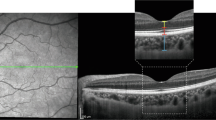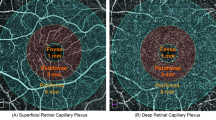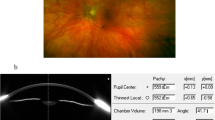Abstract
Purpose
To evaluate the microvasculature alterations in convalescent Vogt-Koyanagi-Harada (VKH) disease using optical coherence tomography angiography (OCTA), and to explore the association between microvasculature and the presence of sunset glow fundus (SGF).
Methods
A cross-sectional study was conducted with 28 VKH patients at convalescent stage and 25 healthy individuals. Both eyes of each participant were enrolled. The VKH patients were classified into two subgroups based on the existence of SGF. OCTA images (3 × 3 mm) were assessed for the data of superficial capillaris plexus (SCP), deep capillaris plexus (DCP), choriocapillaris, and foveal avascular zone (FAZ).
Results
Compared with healthy control eyes and eyes without SGF, the vessel densities of the SCP and DCP decreased significantly in most regions of eyes with SGF (p < 0.0167). No significant difference of vascular perfusion was found between eyes without SGF and control eyes (p > 0.05). VKH patients with SGF had slightly increased FAZ area (p = 0.067) and decreased choroid flow area (p = 0.427) than those in the control group.
Conclusion
Convalescent VKH patients with SGF showed decreased macular capillary perfusion. OCTA could serve as a sensitive tool to assess the microvasculature alterations of VKH disease.
Similar content being viewed by others
Log in or create a free account to read this content
Gain free access to this article, as well as selected content from this journal and more on nature.com
or
References
Read RW, Holland GN, Rao NA, Tabbara KF, Ohno S, Arellanes-Garcia L, et al. Revised diagnostic criteria for Vogt-Koyanagi-Harada disease: report of an international committee on nomenclature. Am J Ophthalmol. 2001;131:647–52.
O’Keefe GA, Rao NA. Vogt-Koyanagi-Harada disease. Surv Ophthalmol. 2017;62:1–25.
Yang PZ, Zhang Z, Zhou HY, Li B, Huang XK, Gao Y, et al. Clinical patterns and characteristics of uveitis in a tertiary center for uveitis in China. Curr Eye Res. 2005;30:943–8.
Pichi F, Sarraf D, Arepalli S, Lowder CY, Cunningham ET Jr., Neri P, et al. The application of optical coherence tomography angiography in uveitis and inflammatory eye diseases. Prog Retin Eye Res. 2017;59:178–201.
Aggarwal K, Agarwal A, Mahajan S, Invernizzi A, Mandadi SKR, Singh R, et al. The role of optical coherence tomography angiography in the diagnosis and management of acute Vogt-Koyanagi-Harada disease. Ocul Immunol Inflamm. 2018;26:142–53.
Jia SS, Zhao C, Gong D, Chen Z, Zhang MF. Optical coherence tomography angiography of acute Vogt-Koyanagi-Harada disease. Zhonghua Yan Ke Za Zhi. 2017;53:735–9.
Luo K, Cai H, Hu Y, Jin C, Gan X, Deng Y, et al. Distinguishing microvasculature features of Vogt-Koyanagi-Harada in patients in acute and convalescent phases using optical coherence tomography angiography. Ocul Immunol Inflamm. 2020:1–7 https://doi.org/10.1080/09273948.2019.1695856.
Keino H, Goto H, Usui M. Sunset glow fundus in Vogt-Koyanagi-Harada disease with or without chronic ocular inflammation. Graefes Arch Clin Exp Ophthalmol. 2002;240:878–82.
Lee EK, Lee SY, Yu HG. A clinical grading system based on ultra-wide field retinal imaging for sunset glow fundus in Vogt-Koyanagi-Harada disease. Graefes Arch Clin Exp Ophthalmol. 2015;253:359–68.
Takahashi H, Takase H, Ishizuka A, Miyanaga M, Kawaguchi T, Ohno-Matsui K, et al. Choroidal thickness in convalescent vogt-koyanagi-harada disease. Retina 2014;34:775–80.
Yang P, Ye Z, Du L, Zhou Q, Qi J, Liang L, et al. Novel treatment regimen of Vogt-Koyanagi-Harada disease with a reduced dose of corticosteroids combined with immunosuppressive agents. Curr Eye Res. 2018;43:254–61.
Dai M-L, Huang X-F, Wang Q-F, Cai W-J, Jin Z-B, Wang Y. CFI-rs7356506 polymorphisms associated with Vogt-Koyanagi-Harada syndrome. Mol Vis. 2016;22:9–17.
Inomata H, Rao NA. Depigmented atrophic lesions in sunset glow fundi of Vogt-Koyanagi-Harada disease. Am J Ophthalmol. 2001;131:607–14.
Abu El-Asrar AM, AlBloushi AF, Gikandi PW, Hardarson SH, Stefánsson E. Retinal vessel oxygen saturation is affected in uveitis associated with Vogt-Koyanagi-Harada disease. Br J Ophthalmol. 2019;103:1695–9.
Karaca I, Yılmaz SG, Afrashi F, Nalçacı S. Assessment of macular capillary perfusion in patients with inactive Vogt-Koyanagi-Harada disease: an optical coherence tomography angiography study. Graefes Arch Clin Exp Ophthalmol. 2020;258:1181–90.
Liang A, Zhao C, Jia S, Gao F, Han X, Pei M, et al. Retinal microcirculation defects on OCTA correlate with active inflammation and vision in Vogt-Koyanagi-Harada disease. Ocul Immunol Inflamm. 2020:1–7 https://doi.org/10.1080/09273948.2020.1751212.
Hashizume K, Imamura Y, Fujiwara T, Machida S, Ishida M, Kurosaka D. Retinal pigment epithelium undulations in acute stage of Vogt-Koyanagi-Harada disease: biomarker for functional outcomes after high-dose steroid therapy. Retina. 2016;36:415–21.
Yang P, Fang W, Wang L, Wen F, Wu W, Kijlstra A. Study of macular function by multifocal electroretinography in patients with Vogt-Koyanagi-Harada syndrome. Am J Ophthalmol. 2008;146:767–71.
Sim DA, Keane PA, Zarranz-Ventura J, Bunce CV, Fruttiger M, Patel PJ, et al. Predictive factors for the progression of diabetic macular ischemia. Am J Ophthalmol. 2013;156:684–92.
Ghasemi Falavarjani K, Iafe NA, Hubschman J-P, Tsui I, Sadda SR, Sarraf D. Optical coherence tomography angiography analysis of the foveal avascular zone and macular vessel density after Anti-VEGF therapy in eyes with diabetic macular edema and retinal vein occlusion. Investig Ophthalmol Vis Sci. 2017;58:30–34.
Borrelli E, Sarraf D, Freund KB, Sadda SR. OCT angiography and evaluation of the choroid and choroidal vascular disorders. Prog Retin Eye Res. 2018;67:30–55.
Borrelli E, Shi Y, Uji A, Balasubramanian S, Nassisi M, Sarraf D, et al. Topographic analysis of the choriocapillaris in intermediate age-related macular degeneration. Am J Ophthalmol. 2018;196:34–43.
Acknowledgements
We would like to thank all of the donors that participated in the present study. This study was supported by the National Students’ Innovation Training Program (201810343005) and XinMiao Talents Program of Zhejiang Province (2018R413036).
Author information
Authors and Affiliations
Corresponding authors
Ethics declarations
Conflict of interest
The authors declare that they have no conflict of interest.
Additional information
Publisher’s note Springer Nature remains neutral with regard to jurisdictional claims in published maps and institutional affiliations.
Rights and permissions
About this article
Cite this article
Fan, S., Lin, D., Hu, J. et al. Evaluation of microvasculature alterations in convalescent Vogt-Koyanagi-Harada disease using optical coherence tomography angiography. Eye 35, 1993–1998 (2021). https://doi.org/10.1038/s41433-020-01210-5
Received:
Revised:
Accepted:
Published:
Issue date:
DOI: https://doi.org/10.1038/s41433-020-01210-5
This article is cited by
-
Clinical characteristics and long-term outcomes of Vogt-Koyanagi-Harada disease in pediatric age group
BMC Ophthalmology (2025)
-
Reduced contrast sensitivity function and outer retina thickness in convalescent Vogt-Koyanagi-Harada disease
Eye (2025)
-
Optical coherence tomography angiography analysis methods: a systematic review and meta-analysis
Scientific Reports (2024)
-
Bibliometric analysis of the Vogt‒Koyanagi‒Harada disease literature
International Ophthalmology (2023)
-
Decrease of choriocapillary vascular density measured by optical coherence tomography angiography in Vogt-Koyanagi-Harada disease
Graefe's Archive for Clinical and Experimental Ophthalmology (2021)



